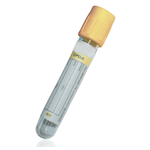Suitable Specimen Types
- Serum
- EDTA Plasma
- Li Hep Plasma
Specimen Transport
First Class PostSample Processing in Laboratory
CentrifugeSample Preparation
2mL Serum (Gel 5mL Yellow tube) or 2mL Plasma (Li Heparin or EDTA). Samples may be stored for 24hrs at 2 - 8C or frozen at -20C for a further 30 days.Turnaround Time
14 daysSample Stability
Not specifiedInhibin A
General Information
Inhibins are heterodimeric protein hormones secreted by granulosa cells of the ovary in the female and Sertoli cells of the testis in the male. They selectively suppress the secretion of pituitary follicle stimulating hormone (FSH) and also have local paracrine actions in the gonads. The inhibins consist of a dimer of 2 homologous subunits, an alpha subunit and either a beta A or beta B subunit, to form inhibin A and inhibin B, respectively.
In females, inhibin A is primarily produced by the dominant follicle and corpus luteum: whereas inhibin B is predominantly produced by small developing follicles. Serum inhibin A and B levels fluctuate during the menstrual cycle. At menopause, with the depletion of ovarian follicles, serum inhibin A and B decrease to very low or undetectable levels.
Inhibin A is the predominant molecular form of inhibin in maternal circulation from 4 weeks of gestation. Although the precise biological function of inhibin A in pregnancy is unclear, it is evident from recent studies that inhibin A could be a better marker of placental function than human chorionic gonadotropin because of its shorter half-life. The possible clinical applications for the measurement of inhibin A in early pregnancy could be in predicting miscarriage, Down's syndrome, preeclampsia, and fetal growth restriction in the first and/or second trimester before the onset of the clinical symptoms. The source of inhibins, factors controlling inhibin production, the possible functions of inhibin, and the use of inhibin measurement in normal and high-risk pregnancy are reviewed.
Ovarian cancer is classified into 3 types: epithelial, stromal sex cord, and germ cell tumors. Epithelial ovarian tumors account for 90% of cases and are further subdivided into: serous (70%), mucinous (10%-15%), and endometrioid (10%-15%) types. Granulosa cell tumors represent the majority of the stromal sex cord tumors, which account for 2% to 5% of all ovarian tumors.
Elevations of serum inhibin A and/or B are detected in some patients with granulosa cell tumors. Inhibin A elevations have been reported in approximately 70% of granulosa cell tumors. In these patients, inhibin A levels tend to show a 6-fold to 7-fold increase over the reference range value. The frequency of elevated levels varies amongst studies, likely due to the different specificities of the antibodies used in the immunoassays.
Inhibin A also appears to be suitable markers for epithelial tumors of the mucinous type with about 20% of cases having elevated inhibin A levels. In contrast, inhibin is not a very good marker in nonmucinous epithelial tumors. At best, total inhibin is elevated in 15% to 35% of nonmucinous epithelial ovarian cancer cases.
Inhibin seems to be a complementary to cancer antigen 125 (CA 125) as an ovarian cancer marker. CA 125 is not as good of a tumor marker for mucinous and granulosa ovarian cell tumors. Inhibin shows a better performance in those 2 types of ovarian cancer.
The majority of the studies for inhibin A and B as an ovarian cancer marker have been limited to postmenopausal women where the levels for both proteins are normally very low. Inhibin A has limited utility as an ovarian cancer marker in premenopausal women, where circulating levels are higher and fluctuate throughout the menstrual cycle and, therefore, are difficult to interpret.
Notes
PRU Handbook of clinical immunochemistry. 9th Edition. 2007. [Ref 1] Robertson DM, et al. Inhibins/activins as diagnostic markers for ovarian cancer. Mol Cell Endocrinol. 2002. 191(1):97-103. [Ref 2] Aitkin DA, et al. Dimeric inhibin A as a marker for Down’s syndrome in early pregnancy. N Eng J Med. 1996. 334:1231-1236. [Ref 3]
Reference Range
Female range - post menopausal 0 - 3.6 pg/mL.
Values in the premenopausal female vary with the stage of cycle 5 - 160 pg/mL.
Male range - 0 - 3.6 pg/mL.
Reference ranges established by manufacturer and validated in-house.
Specifications
- EQA Scheme?: No
- EQA Status: None available.
